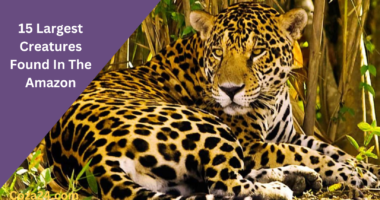Find out “Green Anaconda Vs Giant Anaconda” The world of anacondas is a fascinating one, with two species standing out as true giants in the Amazon rainforest – the Green Anaconda and the Giant Anaconda.

These incredible snakes have captured the imagination of people around the world, but how do they differ? In this article, we will explore the characteristics, similarities, and differences between the Green Anaconda and the Giant Anaconda, shedding light on the queens of the Amazon.
Table of Contents
- 1 Characteristics of Green Anaconda
- 2 Characteristics of Giant Anaconda
- 3 Size Comparison: Green Anaconda vs. Giant Anaconda
- 4 Geographic Range: Overlapping Territories
- 5 Behavior and Temperament: Shared Traits
- 6 Conclusion
- 7 FAQs
Characteristics of Green Anaconda

Size and Weight
The Green Anaconda (Eunectes murinus) is the largest species of snake in the world in terms of weight and girth. Adult females can reach lengths of over 20 feet and weigh more than 200 pounds, while males are slightly smaller, measuring around 10 to 15 feet in length. These massive proportions make the Green Anaconda a true behemoth of the snake kingdom.
Appearance
Green Anacondas have a distinct appearance with their dark green coloration and black spots or blotches along their backs. Their bodies are cylindrical and muscular, allowing them to overpower their prey with ease. They have large heads, equipped with sharp teeth and powerful jaws, perfectly designed for their predatory lifestyle.
Habitat and Distribution
Green Anacondas are primarily found in the Amazon basin and surrounding areas, including the Orinoco and other rivers in South America. They are semiaquatic, spending a significant amount of time in water bodies such as rivers, swamps, and marshes. These habitats provide the perfect hunting grounds for these apex predators.
Characteristics of Giant Anaconda

Size and Weight
The Giant Anaconda is a mythical creature often described in folklore and exaggerated tales. While the existence of a distinct “Giant Anaconda” species is questionable, reports of extraordinarily large anacondas have persisted. Some claims suggest lengths of up to 50 feet, but these reports lack scientific evidence and are likely exaggerated.
Appearance
The appearance of the so-called Giant Anaconda would likely be similar to that of the Green Anaconda, given their close relation. However, without concrete evidence or specimens, it is challenging to provide an accurate description of the appearance of a true Giant Anaconda.
Habitat and Distribution
As with the existence of a distinct Giant Anaconda species, their habitat and distribution remain a mystery. The Amazon rainforest and its surrounding regions serve as the natural habitat for the Green Anaconda, and any claims of a separate species would likely overlap with this range.
Similarities Between Green Anaconda and Giant Anaconda
Taxonomy
Both the Green Anaconda and the hypothetical Giant Anaconda belong to the same genus, Eunectes. This genus includes several species of large constrictor snakes found in South America. The Green Anaconda (Eunectes murinus) is the best-known and scientifically recognized species within this genus.
Diet and Feeding Habits
Both the Green Anaconda and the hypothetical Giant Anaconda are apex predators in their respective ecosystems. They are opportunistic feeders and have a diet primarily consisting of aquatic and terrestrial vertebrates. Their diet may include fish, birds, caimans, capybaras, and other small to medium-sized mammals.
Reproduction
The reproductive behavior of the Green Anaconda and the hypothetical Giant Anaconda is believed to be similar. They are ovoviviparous, meaning they give birth to live young instead of laying eggs. Female anacondas are known for their unique reproductive strategy known as “maternal care,” where they incubate their eggs internally and give birth to fully formed offspring.
Differences Between Green Anaconda and Giant Anaconda
Size and Weight
One of the most significant differences between the Green Anaconda and the hypothetical Giant Anaconda lies in their size and weight. The Green Anaconda holds the title for being the largest snake species in terms of weight and girth. On the other hand, the supposed Giant Anaconda, with claims of lengths up to 50 feet, lacks substantial scientific evidence and remains speculative.
Geographic Range
The Green Anaconda has a well-established geographic range across the Amazon rainforest, including countries such as Brazil, Peru, and Venezuela. Reports of the Giant Anaconda’s presence are often associated with the same regions, indicating a potential overlap in their geographic ranges. However, due to the lack of concrete evidence, the specific distribution and range of the Giant Anaconda, if it exists, remain uncertain.
Behavior and Temperament
The behavioral traits and temperament of the Green Anaconda and the hypothetical Giant Anaconda are not distinguishable due to the limited information available on the latter. However, it is generally understood that anacondas, including the Green Anaconda, are non-aggressive unless threatened or provoked. They prefer to spend much of their time in or near water bodies and are known for their stealthy hunting techniques.
Popularity and Misconceptions
The Green Anaconda has gained significant popularity and notoriety due to its massive size and portrayal in various media. It has been featured in documentaries, movies, and sensationalized stories, often leading to misconceptions about its behavior and potential danger to humans. Similarly, the concept of the Giant Anaconda has become a subject of fascination and speculation, capturing the public’s imagination, but its existence remains unverified.
Conservation Status and Threats
The Green Anaconda is listed as a species of least concern on the International Union for Conservation of Nature (IUCN) Red List. However, habitat destruction, poaching, and the exotic pet trade pose significant threats to their population. Conservation efforts are crucial to ensure the long-term survival of these magnificent snakes and their ecosystems.
Size Comparison: Green Anaconda vs. Giant Anaconda
In terms of confirmed scientific data, the Green Anaconda clearly reigns as the true giant of the Amazon. With its verified lengths of over 20 feet and weights exceeding 200 pounds, it is undoubtedly the largest known species of snake. The supposed Giant Anaconda, with its unsubstantiated claims of exceptional lengths, remains a subject of fascination and speculation without solid scientific proof.
Geographic Range: Overlapping Territories
When it comes to the geographic range, the Green Anaconda has a well-established presence in the Amazon rainforest and its surrounding areas. It can be found in countries such as Brazil, Peru, Venezuela, and other parts of South America. Reports of the Giant Anaconda, if it exists as a separate species, would likely overlap with the range of the Green Anaconda. However, due to the lack of concrete evidence, the specific distribution and range of the Giant Anaconda, if indeed real, remain uncertain.
Both the Green Anaconda and the hypothetical Giant Anaconda, if it exists, are believed to share similar behavioral characteristics. Anacondas, in general, are non-aggressive unless threatened or provoked. They prefer spending a significant amount of time in or near water bodies, such as rivers, swamps, and marshes. These apex predators are known for their stealthy hunting techniques and their ability to overpower their prey by constriction.
Conclusion
In conclusion, the Green Anaconda stands as the true queen of the Amazon, known for its colossal size, powerful presence, and remarkable adaptability. While the existence of the Giant Anaconda remains uncertain and speculative, the Green Anaconda’s attributes have captured our imagination and inspired awe. Understanding the characteristics, similarities, and differences between these majestic creatures allows us to appreciate the marvels of the natural world and the wonders of the Amazon rainforest.
FAQs
1. Can the Giant Anaconda really grow up to 50 feet in length?
The claim that the Giant Anaconda can reach lengths of up to 50 feet lacks scientific evidence and remains speculative. While anacondas, including the Green Anaconda, are known for their impressive size, reports of exceptionally large anacondas should be treated with caution until supported by concrete scientific data.
2. Are Green Anacondas dangerous to humans?
Green Anacondas, like most wild animals, prefer to avoid human contact and are generally non-aggressive unless threatened or provoked. However, due to their size and strength, it is important to exercise caution and respect their natural behavior when encountering them in their habitat.
3. Can Green Anacondas swallow humans whole?
The idea that Green Anacondas can swallow humans whole is a common misconception perpetuated by sensationalized media. While Green Anacondas are capable of swallowing large prey, their diet primarily consists of appropriately sized vertebrates such as fish, birds, and mammals that they can overpower and constrict.
4. Are Green Anacondas endangered?
Green Anacondas are currently listed as a species of least concern on the IUCN Red List. However, habitat destruction, pollution, and illegal hunting for their skin and meat pose ongoing threats to their population. Conservation efforts are essential to ensure their long-term survival.
5. Can Green Anacondas be kept as pets?
Green Anacondas are not suitable pets for the average person. They require specialized care, large and secure enclosures, and a deep understanding of their needs and behavior. Additionally, owning Green Anacondas may be regulated or illegal in certain jurisdictions. It is crucial to prioritize the well-being of these snakes and consider alternative ways to appreciate their beauty and importance in the wild.
See Also | 15 Largest Creatures Found In The Amazon









